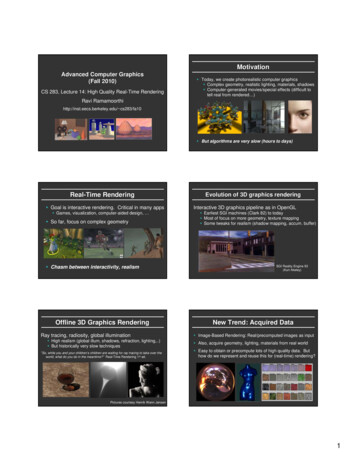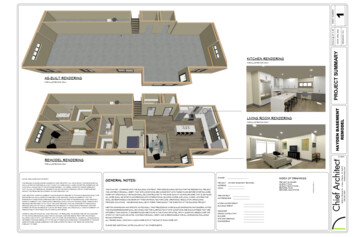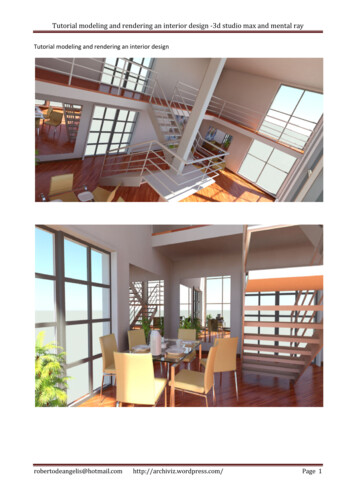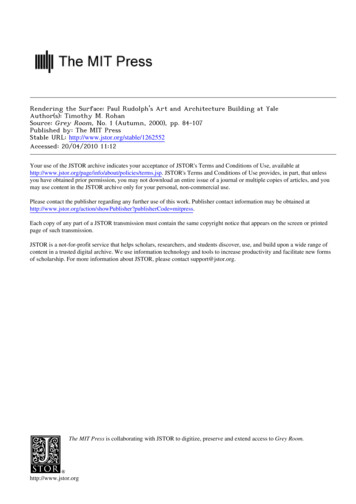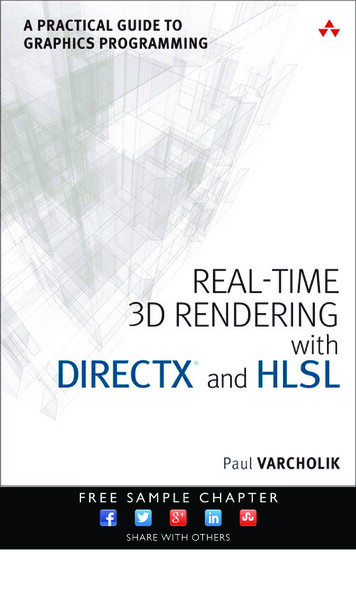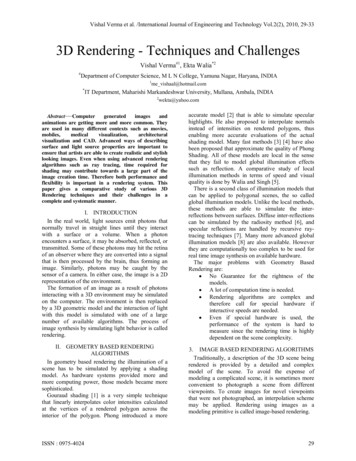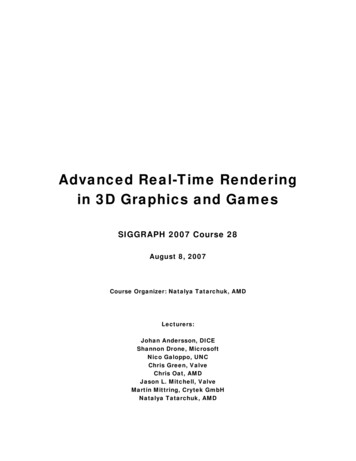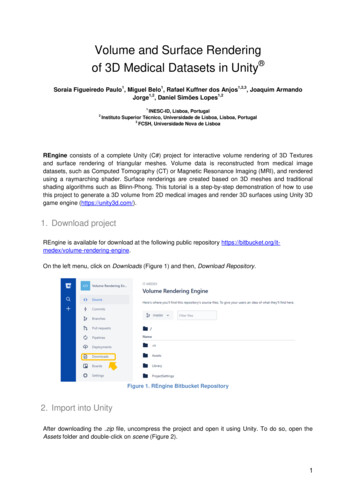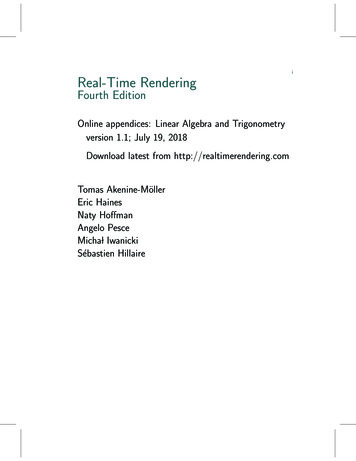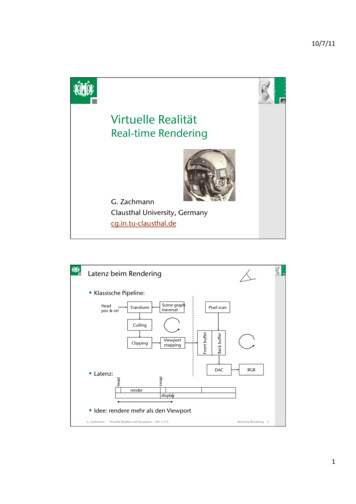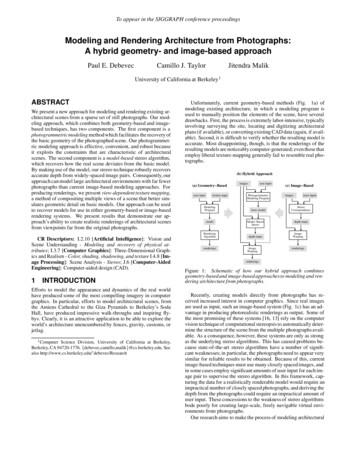
Transcription
To appear in the SIGGRAPH conference proceedingsModeling and Rendering Architecture from Photographs:A hybrid geometry- and image-based approachPaul E. DebevecCamillo J. TaylorJitendra MalikUniversity of California at Berkeley 1ABSTRACTWe present a new approach for modeling and rendering existing architectural scenes from a sparse set of still photographs. Our modeling approach, which combines both geometry-based and imagebased techniques, has two components. The first component is aphotogrammetric modeling method which facilitates the recovery ofthe basic geometry of the photographed scene. Our photogrammetric modeling approach is effective, convenient, and robust becauseit exploits the constraints that are characteristic of architecturalscenes. The second component is a model-based stereo algorithm,which recovers how the real scene deviates from the basic model.By making use of the model, our stereo technique robustly recoversaccurate depth from widely-spaced image pairs. Consequently, ourapproach can model large architectural environments with far fewerphotographs than current image-based modeling approaches. Forproducing renderings, we present view-dependent texture mapping,a method of compositing multiple views of a scene that better simulates geometric detail on basic models. Our approach can be usedto recover models for use in either geometry-based or image-basedrendering systems. We present results that demonstrate our approach’s ability to create realistic renderings of architectural scenesfrom viewpoints far from the original photographs.CR Descriptors: I.2.10 [Artificial Intelligence]: Vision andScene Understanding - Modeling and recovery of physical attributes; I.3.7 [Computer Graphics]: Three-Dimensional Graphics and Realism - Color, shading, shadowing, and texture I.4.8 [Image Processing]: Scene Analysis - Stereo; J.6 [Computer-AidedEngineering]: Computer-aided design (CAD).1INTRODUCTIONEfforts to model the appearance and dynamics of the real worldhave produced some of the most compelling imagery in computergraphics. In particular, efforts to model architectural scenes, fromthe Amiens Cathedral to the Giza Pyramids to Berkeley’s SodaHall, have produced impressive walk-throughs and inspiring flybys. Clearly, it is an attractive application to be able to explore theworld’s architecture unencumbered by fences, gravity, customs, orjetlag.1 Computer Science Division, University of California at Berkeley,Berkeley, CA 94720-1776. fdebevec,camillo,malikg@cs.berkeley.edu. Seealso http://www.cs.berkeley.edu/ debevec/ResearchUnfortunately, current geometry-based methods (Fig. 1a) ofmodeling existing architecture, in which a modeling program isused to manually position the elements of the scene, have severaldrawbacks. First, the process is extremely labor-intensive, typicallyinvolving surveying the site, locating and digitizing architecturalplans (if available), or converting existing CAD data (again, if available). Second, it is difficult to verify whether the resulting model isaccurate. Most disappointing, though, is that the renderings of theresulting models are noticeably computer-generated; even those thatemploy liberal texture-mapping generally fail to resemble real photographs.(b) Hybrid Approach(a) Geometry Baseduser inputtexture gsimagesuser inputPhotogrammetricModeling Programbasic modelModel BasedStereodepth mapsImageWarping(c) Image Basedimages(user input)StereoCorrespondencedepth mapsImageWarpingrenderingsrenderingsFigure 1: Schematic of how our hybrid approach combinesgeometry-based and image-based approaches to modeling and rendering architecture from photographs.Recently, creating models directly from photographs has received increased interest in computer graphics. Since real imagesare used as input, such an image-based system (Fig. 1c) has an advantage in producing photorealistic renderings as output. Some ofthe most promising of these systems [16, 13] rely on the computervision technique of computational stereopsis to automatically determine the structure of the scene from the multiple photographs available. As a consequence, however, these systems are only as strongas the underlying stereo algorithms. This has caused problems because state-of-the-art stereo algorithms have a number of significant weaknesses; in particular, the photographs need to appear verysimilar for reliable results to be obtained. Because of this, currentimage-based techniques must use many closely spaced images, andin some cases employ significant amounts of user input for each image pair to supervise the stereo algorithm. In this framework, capturing the data for a realistically renderable model would require animpractical number of closely spaced photographs, and deriving thedepth from the photographs could require an impractical amount ofuser input. These concessions to the weakness of stereo algorithmsbode poorly for creating large-scale, freely navigable virtual environments from photographs.Our research aims to make the process of modeling architectural
To appear in the SIGGRAPH conference proceedingsinformation while nonlinear minimization methods are prone to difficulties arising from local minima in the parameter space. An alternative formulation of the problem [17] uses lines rather than pointsas image measurements, but the previously stated concerns wereshown to remain largely valid. For purposes of computer graphics, there is yet another problem: the models recovered by these algorithms consist of sparse point fields or individual line segments,which are not directly renderable as solid 3D models.In our approach, we exploit the fact that we are trying to recover geometric models of architectural scenes, not arbitrary threedimensional point sets. This enables us to include additional constraints not typically available to structure from motion algorithmsand to overcome the problems of numerical instability that plaguesuch approaches. Our approach is demonstrated in a useful interactive system for building architectural models from photographs.scenes more convenient, more accurate, and more photorealisticthan the methods currently available. To do this, we have developeda new approach that draws on the strengths of both geometry-basedand image-based methods, as illustrated in Fig. 1b. The result is thatour approach to modeling and rendering architecture requires only asparse set of photographs and can produce realistic renderings fromarbitrary viewpoints. In our approach, a basic geometric model ofthe architecture is recovered interactively with an easy-to-use photogrammetric modeling system, novel views are created using viewdependent texture mapping, and additional geometric detail can berecovered automatically through stereo correspondence. The finalimages can be rendered with current image-based rendering techniques. Because only photographs are required, our approach tomodeling architecture is neither invasive nor does it require architectural plans, CAD models, or specialized instrumentation such assurveying equipment, GPS sensors or range scanners.1.1.3 Stereo Correspondence1.1 Background and Related WorkThe geometrical theory of structure from motion assumes that oneis able to solve the correspondence problem, which is to identify thepoints in two or more images that are projections of the same pointin the world. In humans, corresponding points in the two slightlydiffering images on the retinas are determined by the visual cortexin the process called binocular stereopsis.Years of research (e.g. [2, 4, 8, 9, 12, 15]) have shown that determining stereo correspondences by computer is difficult problem.In general, current methods are successful only when the images aresimilar in appearance, as in the case of human vision, which is usually obtained by using cameras that are closely spaced relative to theobjects in the scene. When the distance between the cameras (oftencalled the baseline) becomes large, surfaces in the images exhibitdifferent degrees of foreshortening, different patterns of occlusion,and large disparities in their locations in the two images, all of whichmakes it much more difficult for the computer to determine correctstereo correspondences. Unfortunately, the alternative of improvingstereo correspondence by using images taken from nearby locationshas the disadvantage that computing depth becomes very sensitiveto noise in image measurements.In this paper, we show that having an approximate model of thephotographed scene makes it possible to robustly determine stereocorrespondences from images taken from widely varying viewpoints. Specifically, the model enables us to warp the images toeliminate unequal foreshortening and to predict major instances ofocclusion before trying to find correspondences.The process of recovering 3D structure from 2D images has beena central endeavor within computer vision, and the process of rendering such recovered structures is a subject receiving increasedinterest in computer graphics. Although no general technique exists to derive models from images, four particular areas of researchhave provided results that are applicable to the problem of modelingand rendering architectural scenes. They are: Camera Calibration,Structure from Motion, Stereo Correspondence, and Image-BasedRendering.1.1.1 Camera CalibrationRecovering 3D structure from images becomes a simpler problemwhen the cameras used are calibrated, that is, the mapping betweenimage coordinates and directions relative to each camera is known.This mapping is determined by, among other parameters, the camera’s focal length and its pattern of radial distortion. Camera calibration is a well-studied problem both in photogrammetry and computer vision; some successful methods include [20] and [5]. Whilethere has been recent progress in the use of uncalibrated views for3D reconstruction [7], we have found camera calibration to be astraightforward process that considerably simplifies the problem.1.1.2 Structure from MotionGiven the 2D projection of a point in the world, its position in 3Dspace could be anywhere on a ray extending out in a particular direction from the camera’s optical center. However, when the projections of a sufficient number of points in the world are observedin multiple images from different positions, it is theoretically possible to deduce the 3D locations of the points as well as the positionsof the original cameras, up to an unknown factor of scale.This problem has been studied in the area of photogrammetryfor the principal purpose of producing topographic maps. In 1913,Kruppa [10] proved the fundamental result that given two views offive distinct points, one could recover the rotation and translationbetween the two camera positions as well as the 3D locations of thepoints (up to a scale factor). Since then, the problem’s mathematicaland algorithmic aspects have been explored starting from the fundamental work of Ullman [21] and Longuet-Higgins [11], in the early1980s. Faugeras’s book [6] overviews the state of the art as of 1992.So far, a key realization has been that the recovery of structure isvery sensitive to noise in image measurements when the translationbetween the available camera positions is small.Attention has turned to using more than two views with imagestream methods such as [19] or recursive approaches (e.g. [1]). [19]shows excellent results for the case of orthographic cameras, but direct solutions for the perspective case remain elusive. In general,linear algorithms for the problem fail to make use of all available1.1.4 Image-Based RenderingIn an image-based rendering system, the model consists of a set ofimages of a scene and their corresponding depth maps. When thedepth of every point in an image is known, the image can be rerendered from any nearby point of view by projecting the pixels ofthe image to their proper 3D locations and reprojecting them ontoa new image plane. Thus, a new image of the scene is created bywarping the images according to their depth maps. A principal attraction of image-based rendering is that it offers a method of rendering arbitrarily complex scenes with a constant amount of computation required per pixel. Using this property, [23] demonstratedhow regularly spaced synthetic images (with their computed depthmaps) could be warped and composited in real time to produce a virtual environment.More recently, [13] presented a real-time image-based renderingsystem that used panoramic photographs with depth computed, inpart, from stereo correspondence. One finding of the paper was thatextracting reliable depth estimates from stereo is “very difficult”.The method was nonetheless able to obtain acceptable results fornearby views using user input to aid the stereo depth recovery: thecorrespondencemap for each image pair was seeded with 100 to 500user-supplied point correspondences and also post-processed. Even2
To appear in the SIGGRAPH conference proceedings2.1 The User’s Viewwith user assistance, the images used still had to be closely spaced;the largest baseline described in the paper was five feet.The requirement that samples be close together is a serious limitation to generating a freely navigable virtual environment. Covering the size of just one city block would require thousands ofpanoramic images spaced five feet apart. Clearly, acquiring somany photographs is impractical. Moreover, even a dense lattice ofground-based photographs would only allow renderings to be generated from within a few feet of the original camera level, precludingany virtual fly-bys of the scene. Extending the dense lattice of photographs into three dimensions would clearly make the acquisitionprocess even more difficult. The approach described in this papertakes advantage of the structure in architectural scenes so that it requires only a sparse set of photographs. For example, our approachhas yielded a virtual fly-around of a buil
and rendering architectural scenes. They are: Camera Calibration, Structure from Motion, Stereo Correspondence, and Image-Based Rendering. 1.1.1 Camera Calibration Recovering 3D structure from images becomes a simpler problem whenthe camerasusedare calibrated, that is, the mappingbetween image coordinates and directions relative to eachcamera is known. This mapping is determined by,
